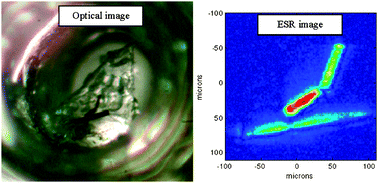Electron spin resonance microcopy (ESRM) is an imaging method aimed at the observation of paramagnetic species in small samples with micron-scale spatial resolution. At present, this technique is pursued mainly for biological applications at room temperature and in relatively low static magnetic fields. This work is focused on the use of ESRM for the measurement of solid samples. First, a brief comparison of various electron spin resonance (ESR) detection techniques is provided, with an emphasis on conventional “induction detection”. Following that, some methodological details are provided along with experimental examples carried out at room temperature and in a static field of ∼0.5 T. These examples show for the first time the imaging of solid samples measured by “induction detection” ESR with a resolution better than 1 μm. Based on these experimental examples and capabilities, an outlook for the future prospects of this methodology in terms of spin sensitivity and resolution is provided. It is estimated that single-spin sensitivity could be achieved for some samples at liquid-helium temperatures and static fields of ∼2 T. Furthermore, under these conditions, spatial resolution could reach the nanometer scale. Finally, a description of possible applications of this new methodology is provided.

You have access to this article
 Please wait while we load your content...
Something went wrong. Try again?
Please wait while we load your content...
Something went wrong. Try again?


 Please wait while we load your content...
Please wait while we load your content...